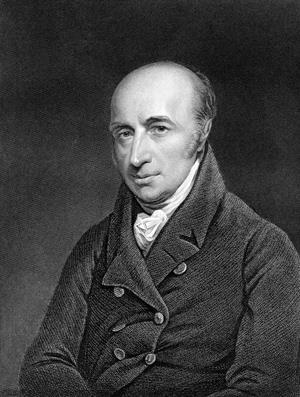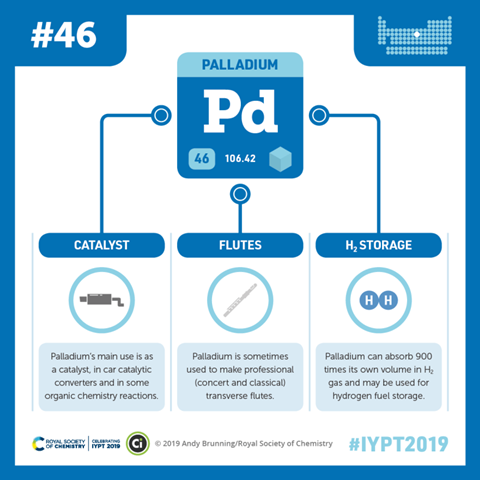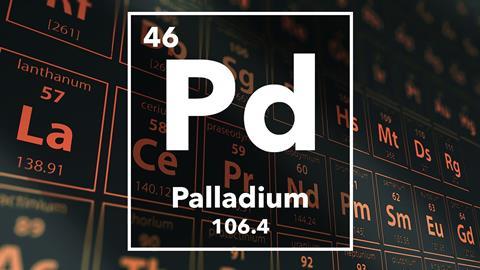Meera Senthilingam
This week, an element whose discovery was announced in a very unique way. So to explain more above the discovery and chemistry of palladium, here's Simon Cotton.
Simon Cotton
For the first 5 years of my life, I lived in the Norfolk market town that was the birthplace of the discoverer of palladium, William Hyde Wollaston.
When he isolated this metal in 1802, he did something quite unique. Instead of announcing it in a reputable scientific journal, he described its properties in an anonymous leaflet, displayed in the window of a shop in Gerrard Street, Soho, in April 1803.

Entitled 'PALLADIUM; OR, NEW SILVER', this handbill described properties of the new element, giving its density and several of its chemical properties, concluding with the announcement that it was sold only at that shop 'In Samples of Five Shillings, Half a Guinea & One Guinea each.'
No one was able to refute Wollaston's claim for a new element, but it was not until 1805 that he published his discovery in a scientific journal.
Palladium is a remarkable metal, not least because it will absorb over 900 times its volume of hydrogen gas. The hydrogen is released again when the metal is heated, so this can be a rather cunning way of weighing hydrogen. And because palladium won't absorb any other gas, you can use this property to purify hydrogen.
At the bottom of our hearts, we know that the age of cheap energy is over. Quite apart from worries about the greenhouse effect and global warming, oil is running out, and the search is on for green alternatives, and palladium is concerned in the most controversial claim that has been made in this area.
Life on Earth relies on the sun. The sun produces energy by fusing hydrogen atoms together to produce helium, a process that requires extremely high temperatures. On March 23 1989, two scientists working in the USA, Martin Fleischmann and Stanley Pons, reported results of room-temperature electrolysis of heavy water using a platinum anode and a palladium cathode. They claimed to have produced excess energy, and suggested that it arose from nuclear fusion reactions. This was seen as a source of cheap energy, possibly solving the world's energy problems.
When hydrogen molecules first come into contact with palladium, they are adsorbed on the surface, but then they diffuse throughout the metal. In palladium saturated with hydrogen, the molecules are extremely close together. Fleischmann and Pons believed that this closeness had led to the energy-producing nuclear fusion reactions happening. Over the last twenty years, no one has been able to reproduce this, and the reaction has passed into the realms of voodoo science.

Palladium does however have a genuine use in 'green' energy, as a catalyst in hydrogen fuel cells. Palladium is one of a number of metals starting to be used in the fuel cells to power a host of things including cars and buses.
Palladium is also widely used in catalytic reactions in industry, such as in hydrogenation of unsaturated hydrocarbons, as well as in jewellery and in dental fillings and crowns.
But the main use of palladium, along with rhodium and platinum, is in the three-way catalytic converters in car exhaust systems. Untreated, car exhaust fumes contain several undesirable gases, and the purpose of the catalytic converters is to eliminate them. They are called three-way converters as they reduce three types of harmful emissions. Converting toxic carbon monoxide into carbon dioxide; the hydrocarbons in unburned fuel into carbon dioxide and water; and toxic oxides of nitrogen (which can contribute to smog and acid rain) into harmless nitrogen gas.

So, that's palladium – a metal with humble beginnings that now plays a major role in industrial catalysis, powering and cleaning up after our vehicles and even makes the occasional appearance in our jewellery boxes, and even in our mouths.
Meera Senthilingam
Quite the catalyst that palladium! Providing energy in fuel cells, protecting our environment through catalytic converters, and providing aesthetic pleasure in jewellery and even dentistry. That was Simon Cotton, from Uppingham School in the UK, with the chemistry of palladium.
Next week, an element that certainly doesn't deserve to be called boring.
Louise Natrajan
There is a famous quote about the lanthanides by Pimentel and Sprately from their book, Understanding Chemistry published in 1971: 'lanthanum has only one important oxidation state in aqueous solution, the +3 state. With few exceptions, this tells the whole boring story about the other 14 elements.'
If you've listened to any other of the podcasts in the lanthanide series, I hope you'll agree that this is far from true. While, the most common oxidation state of the lanthanides is indeed the +3 valence state, ytterbium, the last and smallest of the lanthanides or rare earths in the series is one of the exceptions Pimentel and Sprately were talking about.
Meera Senthilingam
And Louise Natrajan will be revealing the true – exciting – nature of ytterbium that makes it one of the exceptions, in next week's Chemistry in its element. Until then, I'm Meera Senthilingham, and thank you for listening.













No comments yet